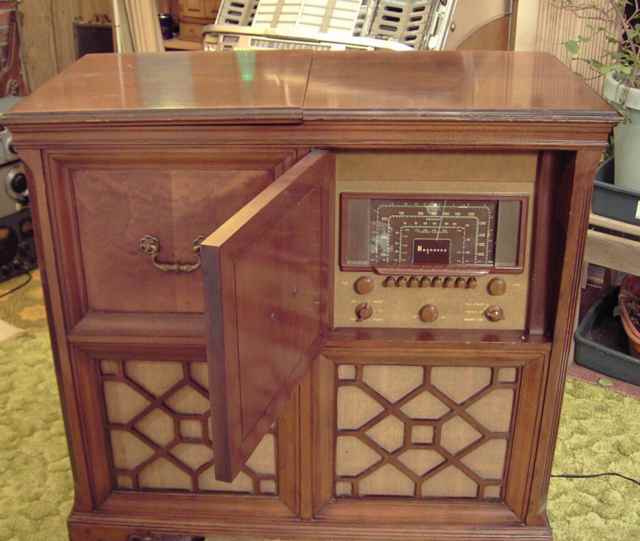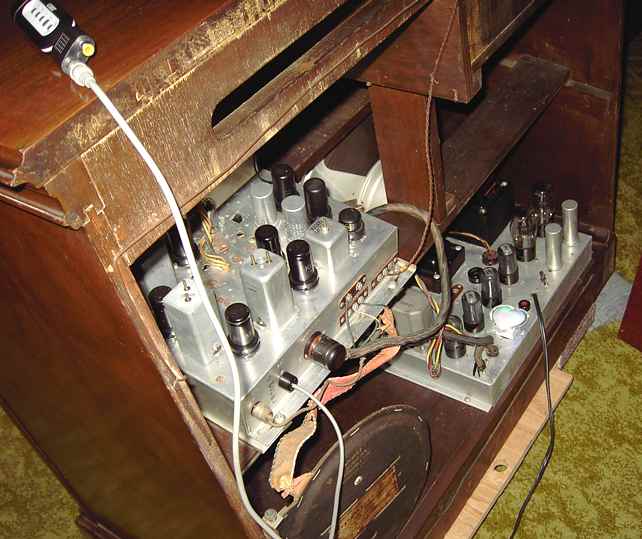In addition to tube-type communication gear, I occasionally enjoy working on antique entertainment radios. This 15 tube Magnavox model 342K console radio/phono was complicated enough to intrigue me. The set is definitely a "cut above" the typical home entertainment system. Dating from 1947, it covers the AM broadcast band, the short waves from 5.5 to 17 MHz, and the "new" post-war FM band. It also features separate Bass and Treble controls, a wide "hi-fi" IF bandwidth for AM/ SW complete with a 10KHz inter-station whistle filter, and a "sharp" selectivitity position on the treble switch that reduces that wide IF bandwidth on a crowded shortwave band. It has one RF amp stage, two IF stages for AM/ SW and a limiter/ discriminator circuit for FM detection. It also has a switch-selected "external" line input that will enable connecting a more modern device for tube-era sound.
The amp sports four 6V6 output tubes in transformer-coupled push-pull parallel providing lots of output for that nice "tube" sound from two 12 inch electro-dynamic speakers. The power is supplied by two parallel 5Y3G rectifiers. It also has a power-line fuse and even comes with a spare fuse as can be seen on the top of the AMP chassis. A fuse is relatively rare in home entertainment sets of the era.
Schematics
For Magnavox, the console model number is not used for schematic identification. Identification is via the model numbers on the separate chassis. The amplifier is AMP 109 and the receiver is model CR-202. The schematics for these are found in Rider's volume 18 which is available, like most of the Rider manuals, for downloading for free from Nostalgia Air. The two chassis are not listed in Sams Photofacts but similar chassis can be found in Sams 68, 41, and 43. The Sams are useful for voltage checks at the tube sockets and for component identification.
Trouble-shooting
I replaced the line cord with a polarized version and rewired the fuse connection per modern standards. The line (hot) side of the polarized power cord goes directly to the deepest contact on the chassis fuse holder and the other side of the fuse goes to the power switch. I replaced the three Micamold .02 MF caps connected to the power line because all were leaky. Replacement was with a modern cap designed for power line connection. Used deoxit on all tube and connector sockets and the switches and controls.
Next, I pulled the rectifier tubes and checked the transformer for the usual filament and transformer heating test. Found that the 6H6 FM discriminator tube did not heat up. Located a replacement. It is rare that I find tubes with open filaments. After reforming the electrolytic caps with a separate power supply, I replaced the rectifiers and did a slow power-up with my isolated variac. Voltages were low in the AMP unit. Checked for leaky audio coupling caps. AMP 109 has two 0.1 MF caps in an interesting inverse feedback circuit (plate of each 6V6 feeds low side of each input transformer secondary via that cap). Those caps were leaky and were replaced. (NOTE: these are incorrectly labeled as 0.01 MF on the schematic. They were replaced with 0.1 caps as originally supplied.) Also checked and replaced the main audio coupling caps of the two 6J5 tubes on the receiver chassis. After this, the radio played quite well on AM and SW but very poorly with distortion on FM. Did a voltage check. Found the limiter plate voltage swinging erratically even with a station tuned in properly. Checked the resistors and caps in the plate circuit by disconnecting from the discriminator transformer. Found a high resistance leakage between the primary and the secondary of the transformer. Opened the discriminator transformer expecting to find leaky small caps. The caps in this transformer are sealed between two layers of insulation. Saw what looked like a layer of solder flux on top of this insulation. Cleaned this layer off with contact cleaner. Checked the transformer again and found no more high-resistance leakage. Remounted and reconnected the transformer and tried the set again. This time the FM had excellent sound with no apparent distortion.
More later
Tweaked the RF amp alignment on AM and SW. The adjustment caps are nicely labeled and engraved on the receiver chassis.
The eye tube was very dim. Found a good used spare 6U5/6E5 and replaced it for a nice green glow that nearly closes on strong AM stations and closes completely on strong FM.

MP3 sound power
As shown in the picture below, the set has a line input for an external audio source and an "EXT" setting for the bandswitch knob along with AM, FM, SW and phono. After modifying an automotive stereo connector plug to fit the Magnavox external input jack, I made an adapter cable and connected my MP3 player. The result is powerful sound for modern music, rock and roll, and the music of the Magnavox's youth that easily rivals any jukebox of the era! A great way to listen to one's favorite selections for that vinyl sound without wearing out the vinyl or needles.

An old high-quality homebrew Ham Bands Receiver was the previous item on the bench.